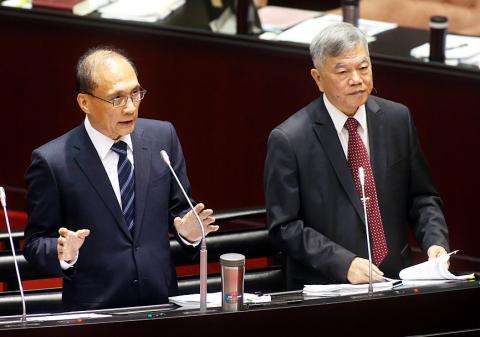Spare nuclear power can be tapped to ensure a stable power supply in the event of an emergency, Premier Lin Chuan (林全) said in an interview published yesterday as he reaffirmed the government’s energy transition goals.
Although the government plans to phase out nuclear power, a reactor at the Guosheng Nuclear Power Plant could be reactivated when necessary, Lin said in an interview with the Chinese-language Liberty Times (sister newspaper of the Taipei Times).
“Although [the reactor] is not considered part of the operating reserve, I would make a formal report to the Legislative Yuan to reactivate it as a last resort in the event of a predictable power shortage. The manufacturing industry should have confidence in the power supply,” Lin said.

Photo: CNA
However, he reaffirmed the government is committed to phasing out nuclear power while boosting natural gas-generated power and renewable power to 50 percent and 20 percent of the total power generation respectively, and reducing coal-fired power to 30 percent by 2025.
“Taiwan has few natural resources and there are problems with either nuclear power, coal-fired power or natural gas-fired power. We have to make a choice, but nuclear power is too dangerous. The nation would be endangered in case of a nuclear disaster,” he said.
Pressed by reporters about Lin’s comments, Executive Yuan spokesman Hsu Kuo-yung (徐國勇) yesterday said that the reactor would only be used as a last resort to maintain an adequate power supply.
“Unless there is no other way to keep power from running short, there are no safety concerns, and society agrees to reactivate the idle nuclear reactors, the reactors at the first and second nuclear power plants will not be restarted,” Hsu said.
The shutdown of a power plant in Hualien County after a typhoon last month downed a transmission tower resulted in contingency energy-saving measures, and the malfunction of a power plant in Taoyuan that caused a massive outages around the nation on Aug. 15 have pointed to grid management problems, not the need for nuclear power generation, Lin said.
The Democratic Progressive Party, shortly after it won the general elections last year, told Taiwan Power Co (台電) to plan an electricity supply scheme without extending the lifespan of the nation’s three active nuclear power plants or activating the mothballed Fourth Nuclear Power Plant, Lin said.
Wind and solar power and a stable grid storage system have to be developed to ensure uninterrupted supply in off seasons to achieve such a goal, and a “smart” grid system has to be established to reduce power consumption during peak hours, he said.
The development of solar power, although technically more viable, is limited to land availability, so wind power has more potential than solar power, he said.
Major wind power farms could begin operations in 2020, and they could generate about 3.5 gigawatts (GW) to 4GW by 2025 when all three operating nuclear plants are due to be decommissioned, he said.
It is important to reduce peak hour consumption to maintain stable supplies without building more power plants, Lin said.
A “smart” household meter system would allow users to know real-time consumption and encourage them to adopt a flexible electricity pricing system, which demands a high rate during peak hours while offering during off-peak times.
The government has been developing a “smart” meter system, with 1 million households set to install the system by the end of 2019 and 3 million households in 2020, he said.
Additional reporting by CNA

The Central Weather Administration (CWA) yesterday said it expected to issue a sea warning for Typhoon Fung-Wong tomorrow, which it said would possibly make landfall near central Taiwan. As of 2am yesterday, Fung-Wong was about 1,760km southeast of Oluanpi (鵝鑾鼻), Taiwan’s southernmost point, moving west-northwest at 26kph. It is forecast to reach Luzon in the northern Philippines by tomorrow, the CWA said. After entering the South China Sea, Typhoon Fung-Wong is likely to turn northward toward Taiwan, CWA forecaster Chang Chun-yao (張峻堯) said, adding that it would likely make landfall near central Taiwan. The CWA expects to issue a land

Taiwan’s exports soared to an all-time high of US$61.8 billion last month, surging 49.7 percent from a year earlier, as the global frenzy for artificial intelligence (AI) applications and new consumer electronics powered shipments of high-tech goods, the Ministry of Finance said yesterday. It was the first time exports had exceeded the US$60 billion mark, fueled by the global boom in AI development that has significantly boosted Taiwanese companies across the international supply chain, Department of Statistics Director-General Beatrice Tsai (蔡美娜) told a media briefing. “There is a consensus among major AI players that the upcycle is still in its early stage,”

The Central Weather Administration (CWA) yesterday said it is expected to issue a sea warning for Typhoon Fung-wong this afternoon and a land warning tomorrow. As of 1pm, the storm was about 1,070km southeast of Oluanpi (鵝鑾鼻), Taiwan’s southernmost point, and was moving west-northwest at 28 to 32kph, according to CWA data. The storm had a radius of 250km, with maximum sustained winds of 173kph and gusts reaching 209kph, the CWA added. The storm is forecast to pass near Luzon in the Philippines before entering the South China Sea and potentially turning northward toward Taiwan, the CWA said. CWA forecaster Chang Chun-yao (張峻堯) said

Japanese Prime Minister Sanae Takaichi yesterday said that China using armed force against Taiwan could constitute a "survival-threatening situation" for Japan, allowing the country to mobilize the Japanese armed forces under its security laws. Takaichi made the remarks during a parliamentary session while responding to a question about whether a "Taiwan contingency" involving a Chinese naval blockade would qualify as a "survival-threatening situation" for Japan, according to a report by Japan’s Asahi Shimbun. "If warships are used and other armed actions are involved, I believe this could constitute a survival-threatening situation," Takaichi was quoted as saying in the report. Under Japan’s security legislation,